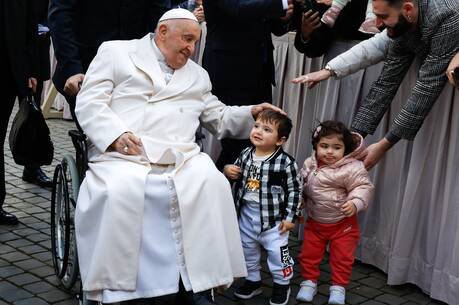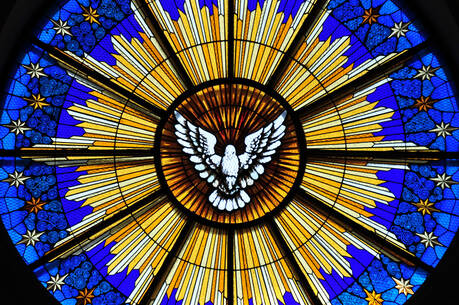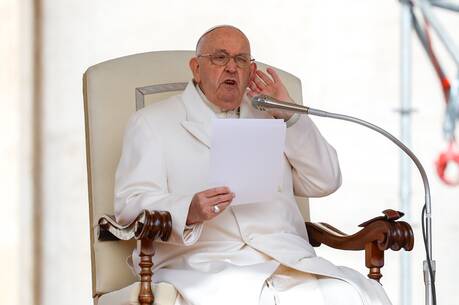Cambridge, MA. It is May 1 in the morning, about 9:30 AM. I am just back from Church, the 7:30 Mass, the quiet early Mass. It is a beautiful morning. At dawn, by the Charles River, hundreds of romantics were marking May Day and dancing around Maypoles. Preparations were under way for the annual Walk for Hunger, which brings together tens of thousands of compassionate people, young and old, to walk 20 miles for raise money for Boston’s neediest citizens. Though not at the 7:30 Mass, the parish is celebrating a number of First Communions today, another cause for joy. And the first reading from the Acts of the Apostles puts forward a splendid view of the Church as community: “All who believed were together and had all things in common; they would sell their possessions and goods and distribute the proceeds to all, as any had need. Day by day, as they spent much time together in the temple, they broke bread at home and ate their food with glad and generous hearts, praising God and having the goodwill of all the people.”
Of course too, many of us — perhaps most? — Catholics saw this very same Church brilliantly evident in Rome this morning, where massive crowds gathered to mark the beatification of John Paul II and to praise God together in St. Peter’s Square. But it is also true that some of us doubted: is the prospect of this Pope beatifying his predecessor really the manifestation of what the Easter Church can be, at its best? As Austin Ivereigh has already eloquently pointed out, there is ongoing debate about the speed of this beatification, about the direction of the post-Vatican II Church and, I would add, about where we are after – or during - the abuse crisis, and in a Church were issues about ministry and leadership in the Church bother so many of us. What’s a good Catholic to do, on this lovely day? 
Perhaps one very good thing to do is to thank God for today’s timely Gospel, the scene from John 20 that culminates in the story of the Thomas who doubted what the others had seen, Jesus’ earlier visit. Wherever we are across the spectrum, we need to hear Jesus’ words: “Have you believed because you have seen me? Blessed are those who have not seen and yet have come to believe.” The story needs no repeating here, but I think we can rehabilitate Thomas a bit, and clarify the point of the story. That he did not believe his fellow apostles, Peter included — and this even before Thomas went to India — may have been a deficiency on his part. We cannot give much credit to that larger crowd, former disciples who were not in that upper room. Some had simply walked away when they could no longer see Jesus as they used to see him; some were probably shocked at the betrayal of Judas and the cowardice of Peter. But it also follows that not too much credit should be given to Thomas’ fellow apostles, who believed because they had seen. 
Thomas was a man in the middle: still there, not giving up, but without the clear, certain faith his friends had. He was honest enough not to keep his doubts to himself. He was not ashamed to be a little out of place in this new, ideal community, and he was not afraid of what Peter might say. He insisted that he needed more evidence, and not just by way of the experience of others; until a second visit by Jesus, he was not finding it easy to believe. None of the many words of the majority could change his mind, as Jesus knew would be the case.
Today’s Church is in a similar position: There are those who see in the Church as it is, in John Paul II’s legacy, under Benedict’s firm hand, and in St. Peter’s Square, the manifest form, evident visibility of God’s Church so very evident, obvious, and wonderful. There are those who have walked away from it all — still Catholic but for a variety of personal and communal reasons unable to bear to be inside today’s Church. And there are those like Thomas, still in the Church, still very much in the midst of the community, who cannot at the moment see what the first group says it has seen, but are also unwilling to walk away from it all.
That first Easter season was a better, truer, graced moment because Thomas was still there, bearing his doubts and standing by them until Jesus came back, and showed himself, wounds and all. Our Church is a better one when we realize who we are: some of us see what we have been hoping to see, some of us don’t see it at all, and some of us stand in the middle, hoping for but not seeing the Church they want to see, yet also graced to stick with it, living out May 1 in holy doubt.







-T.S. Eliot
First, while I admire much that John Paul II did during his long ministry as Pope, I am not sure the question of sainthood should have come up so quickly. John Paul II did ...or failed to do...a number of things which might well cause even one disposed to evaluate him positively to pause and take a slower walk.
Fr. Clooney's final paragraph is marvelous, and in my view, accurate. Sadly, I do not believe that the institutional Church is able to address the complexity of this very mixed reality called the Church honestly and openly and neither is it particularly eager to do so.
Regrettably, many institutions do not seem capable of managing the legitimacy of internal ''doubting Thomas'' types. Triumphalism seems to trump critical thought.
To all those who might be trapped in the conundrums outlined in Fr. Clooney's fine piece, I suggest this: thank God we don't depend on the institution for the Resurrection of the Lord.
Philip Garmey
Lynchburg,Virginia
I've no doubt that liberal "Catholics" can find a way to steer any piece of scripture to validate their desire to reform the Church. They could take transubstantiation and claim that the "changing" of bread into flesh was intended as a sign that the Church should be in a constant state of change.
Response: Mr Brooks, excellent idea. Bread is just bread, wine is just wine, until they are changed within the Church comumunity at prayer. An analogy one might go far with. FXC
As always, written with subtlety and sensitivity. But somehow I miss the climax of the Gospel: ''my Lord and my God!'' Seeing or not seeing that is the incredible Good News we are invited to believe.